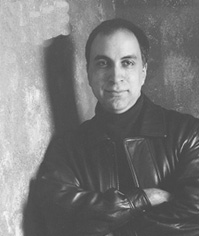
Composer Anthony Cornicello (born in Brooklyn, New York, 1964) writes music that blurs distinctions between performers and electronics, timbre and harmony, composition and improvisation, and explores the boundaries of what may be considered post-classical concert music. His music is vibrant and visceral, full of rhythmic energy and harmonic sophistication, and his forays into live electronics have led to exciting combinations of instruments and processed sound. Cornicello’s background as a jazz pianist is evident not only in the rhythmic activity of his music, but also in his constant investigation of the rich sonorities available from a variety of instruments.
He has been commissioned to write music for the Scorchio Electric String Quartet, ModernWorks! (funding from Meet the Composer/ Commissioning Music USA), the Auros Group for New Music, the Prism Saxophone Quartet, the New York New Music Ensemble, David Holzman, the Group for Contemporary Music, and the InterEnsemble of Padova, Italy. His work has also been featured on the Guggenheim Museum’s “Works and Process” series. Cornicello’s works have also been performed by the Chicago Civic Symphony, Parnassus, ALEA III, Composers Concordance, Madeleine Shapiro, Robert Black, among many other outstanding groups and solo performers. His music has been presented as part of the Darmstadt International Festival of New Music as well as the June in Buffalo Festival.
Cornicello’s Second String Quartet has been recorded by the Atlantic String Quartet; the Second Sonata for Piano by David Holzman (Centaur). More recently, his Post-Modern Waltz was recorded by Eric Moe for Albany Records. A portrait CD of Cornicello’s works is scheduled for 2006 release on Albany Records.
As a performer, he has conducted or played piano in his own works on numerous occasions. While a graduate student at Rutgers, he formed and directed the Janus Ensemble, a group dedicated to contemporary music. More recently, Cornicello has begun performing on the laptop, using a variety of interfaces and the Max/MSP program. Those performances, mostly with EEE!, have had a notable impact on his music, as EEE!’s music ranges from hip-hop to experimental noise. EEE! is based at Eastern Connecticut State University, where Cornicello is an Associate Professor and Director of the Electronic Music Lab.
Cornicello received the Ph.D. from Brandeis University, where he studied with David Rakowski, Eric Chasalow, and Martin Boykan. His teachers also include Charles Wuorinen, Gérard Grisey, and Richard Beirach.
His current fields of interest include developing unusual interfaces for live computer music performances, as well as continuing to investigate resonance and spatialization. His recent and current projects (mostly for string instruments and electronics) have been exploring the latter two, and the series of experimental works ReZenant Garden, performed by EEE! have operated on all three areas of interest. Future projects will include works for instrumental groups or soloists and electronics, as well as turntablists.
Cornicello's works are published by C.F. Peters Corporation and APNM, and he is a member of BMI.
|
|
|
|
|
|

Saturday, November 12, 2005
Electro-acoustic classics, part one
I've decided to put my blog to good use: to talk about some electro-acoustic classics. I'm not making a 'best of' list (not yet, anyway), but I'd like to use this a forum for discussing electro-acoustic works that I feel are influential, important, unusual, or just plain cool. You'll find that I have a broad definition of what falls under the electro-acoustic banner, so don't be surprised if unusual names pop up.
I'm going to start with one that most likely won't be controversial: Etude Aux Chemins de Fer by Pierre Schaeffer. This is often cited as one of the first pieces of the whole Musique Concrète genre. The recording itself is quite simple, in some ways: Schaeffer took a collection of railroad sounds, assembled them in a order that seems to depict a journey. The piece itself is quite short, about 3 minutes long.
Schaeffer himself had a rather primitive lab. According to Peter Mannings "Electronic and Computer Music", the earliest recordings were made directly on to an "LP". There was little room for fancy editing, multitracking, and all the devices we associate with present-day recording technologies. He even had a playback device that seems to pre-sage the Mellotron by about 2 decades.
What's more fascinating is the listing in the Manning book about how Schaffer classified and defined the sounds with which he was working. His list, codified a few years after the Etude, demonstrates the amount of thought and care that went into producing one of these works. And it shows a flair for timbres - how they may be composed and transformed within a piece.
Admittedly, I'm including this piece mainly because it was the first. But Musique Concrète is a remarkable step in music history. For the first time, a piece can be presented without a performer, or any sort of instrument like the player piano. The piece cannot be re-interpreted by performers - what you're hearing is the un-adulterated composer's vision. It gave birth to the whole genre of 'tape music'.
The idea of un-interpretable music may seem a bit strange, but we've all experienced it. We have all heard our favorite recording, and when we hear another version of that piece, we sense that something is amiss. The problem is amplified with music that includes improvisation. Rock fans often complain about live performances not 'sounding like the record'. Perhaps Shaeffer was already in tune with this phenomenon, and decided to make use of it: the Musique Concrète pieces cannot be 're-recorded' (well, I guess they could) or changed in any way. There is no difference between the 'score', the recording, and any 'performance' of the piece.
posted by Anthony Cornicello
|
| |



